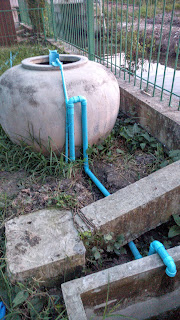We have been using a slow sand filter to treat our gray water for some months now and it has been working quite well. There was a problem due to normal intermittent use that the water level would drop due to evaporation and expose the sand, which basically kills off the biofiltration layer, but we fixed this by raising the level of the output PVC pipe.
Basically, the output PVC pipe acts as a kind of weir. By requiring the water that comes out the bottom of the sand filter to climb up a PVC pipe of a certain height before falling back down, the water pressure of the water going through the sand filter urn is actually proportional to the difference in height of the water level inside the urn and the height of the output PVC pipe. Thus, when these levels equalize the sand filter stops passing water through. By raising or lowering this level, you can control the height at which the incoming water stops being filtered and keep the biological layer in the sand filter from drying out. (But as I’ve learned, you need a little extra because the incoming water will still evaporate.)
Other than that, the system worked well.
That is, until we finally got around to mounting the final stretch of PVC pipe from the sand filter to the cistern.
Here is a picture:
You can see the smaller inlet PVC pipe climbing up the side of the sand filter urn to the top where it drops the graywater onto the diffuser plate inside. Then the water filters down through the layers of:
- Burnt rice husk
- Fine sand
- Course sand
- Fine gravel
- Course gravel


